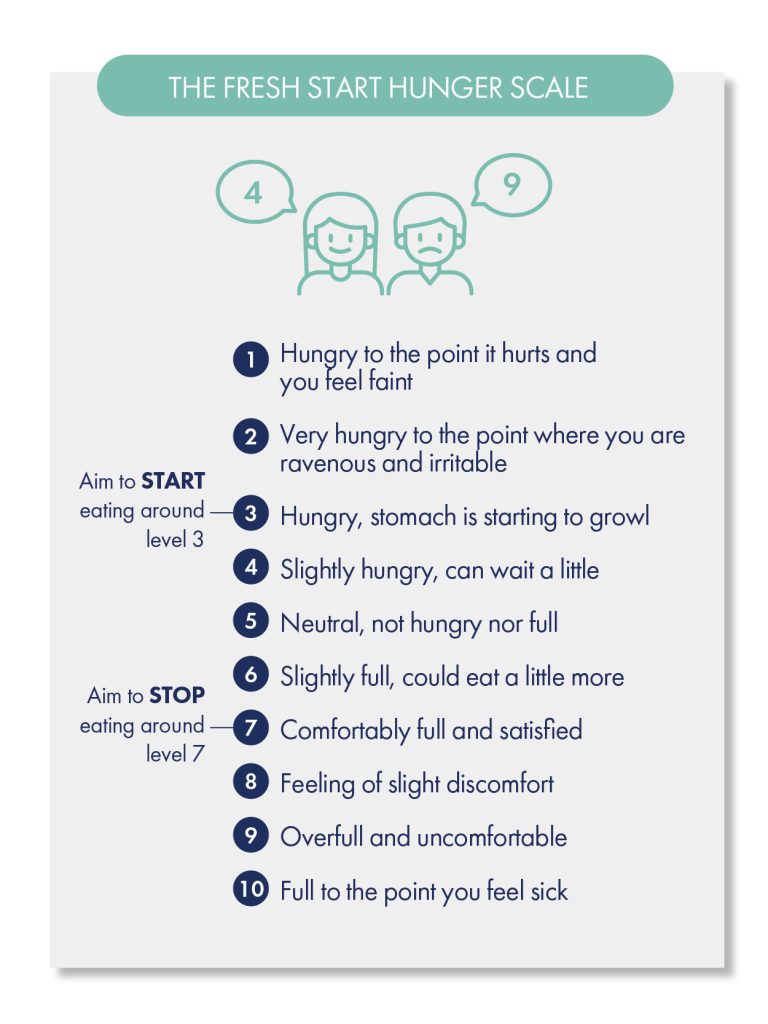Hands up if you often eat while driving, at your desk or while scrolling your phone? You’re not alone! In today’s fast-paced world it’s become socially acceptable to eat and multitask. The downside? It means we eat quickly and don’t enjoy our meal as much as we could. We cover 5 tips to become a more mindful eater.

What is mindful eating?
An easy way to think about mindful eating is that it’s paying attention to ‘how’ we eat food (1).
It means that you’re:
- Listening your body, tuning into your appetite and taking a moment to decide whether you feel hungry before eating.
- Being fully present while eating. For many people this means slowing down and noticing the smell, texture, taste, flavours and temperature when taking each bite.
- Eating until you feel satisfied and realising when you’ve had enough.
- Eating nourishing and delicious food and giving yourself permission to enjoy it!
- Appreciating where your food has come from and the resource that have gone into growing and preparing it whether that was by you or someone else.
The good news? When we practice mindful eating, we can fully embrace the joy of eating. We may also become better at telling the difference between our physical hunger and emotional hunger which can improve our relationship with food (2).
Although there isn’t any good evidence to suggest that mindful eating improves diet quality or our food intakes, many people find they feel more satisfied when they eat in this way (3).
5 easy ways to be more mindful
1. Put down your phone
If you eat and scroll it makes it virtually impossible to eat mindfully and feel satisfied. Put your phone aside so that you can fully enjoy your meal.
2. Use a plate and sit down
Standing at the cupboard or eating straight out of a packet leads to grazing and not knowing how much you’ve eaten! Whether it’s a snack or main meal, always put your food onto a plate, sit down and take a moment to enjoy it.
3. Listen to your inner voice
Before you eat, ask yourself: am I physically hungry, or am I tired, bored, stressed, or thirsty? This small pause helps you spot the difference between emotional hunger and physiological hunger (where your body needs food).
4. Rate your hunger
Use a hunger scale from 0-10 before and after meals. This helps you understand how much you need to eat and gives you permission to stop when satisfied. It is a great tool for encouraging intuitive eating and listening to your body.
Give yourself permission to leave food on your plate. You can always package it up for tomorrow’s lunch or have the rest at another meal.

5. Chew, chew, chew
Slow down and focus on the first few bites. Reducing the speed at which you eat benefits your digestion. Chewing more also gives your brain and stomach time to communicate, helping you feel satisfied before you get too full.
How meal prep supports mindful eating
It’s tough to make mindful choices when you’re tired or hungry. That’s often when emotional or convenience eating sneaks in. Meal prep is a practical way to support mindful eating because it removes the stress of deciding what to eat in the moment.
Here are some simple prep ideas that make mindful eating easier:
- Plan ahead with flexibility: Slot in some time each week to plan your meals and snacks – just like you would book in exercise classes. Meal plan before you write your grocery list or select your Fresh Start recipes. Be realistic and factor in nights off cooking or social meals so your plan works for you.
- Cook once, eat twice: Double dinner and save leftovers for lunch the next day.
- Batch cook protein: Prepare chicken, tofu, lentils or eggs at the start of the week so they are ready to add to meals.
- Snack prep with variety: Choose one snack to prep each week: homemade hummus with veggie sticks or roasted chickpeas – to keep things interesting.
- Toast your nuts and seeds: Dry toast a batch to elevate your snack game or add a tasty, nutritious topping to salads, yoghurt or a brekkie bowl!

Challenge yourself
This week, set one small goal that will help you eat more mindfully and stay prepared.
Here are five ideas to try:
- Plan your meals and write your grocery list before the week begins
- Put your phone away at every meal and focus fully on your food
- Batch cook one protein (like chicken, tofu or eggs) to use across several meals
- Prep a new snack for the week and have it ready when hunger strikes
- Take at least 20 minutes to enjoy one main meal each day without distractions
Finally…
Remember like all new skills, it can time to develop a new behaviour and with enough repetition you can re-wire your brain to take a different approach to food. It’s unrealistic to mindfully eat every moment of each day, but small steps to become a more conscious eater will have a positive impact during the Reset and beyond.
References
(1) Nelson JB. Mindful Eating: The Art of Presence While You Eat. Diabetes Spectr. 2017 Aug;30(3):171-174.
(2) Morillo-Sarto Het al. ‘Mindful eating’ for reducing emotional eating in patients with overweight or obesity in primary care settings: A randomized controlled trial. Eur Eat Disord Rev. 2023 Mar;31(2):303-319. doi: 10.1002/erv.2958. Epub 2022 Nov 17.
(3) Ruffault Aet al. The effects of mindfulness training on weight-loss and health-related behaviours in adults with overweight and obesity: A systematic review and meta-analysis. Obes Res Clin Pract. 2017 Sep-Oct;11(5 Suppl 1):90-111. doi: 10.1016/j.orcp.2016.09.002. Epub 2016 Sep 19.


